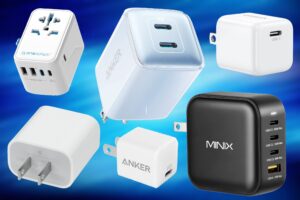Looking to charge your batteries without the need for expensive equipment? Look no further! In this article, we will show you how to make a homemade battery charger using simple materials that you probably already have lying around. No need to head to the store or break the bank – all you need are a few common household items and a little bit of know-how. So, without further ado, let’s dive straight into how to make a homemade battery charger that will keep your devices powered up and ready to go!
How to Make a Homemade Battery Charger
Have you ever found yourself in a situation where you need to charge your batteries but don’t have access to a traditional charger? Maybe you’re out camping or on a road trip, and your devices are running low on power. Well, worry no more! In this article, we will guide you through the process of making a homemade battery charger that you can use in emergencies or when you’re on the go.
Understanding Battery Basics
Before we dive into the process of making a homemade battery charger, it’s important to have a basic understanding of how batteries work. Batteries store electrical energy and provide power to various devices such as smartphones, laptops, and cameras. They consist of one or more electrochemical cells that convert chemical energy into electrical energy.
Different types of batteries exist, including alkaline batteries, lithium-ion batteries, and nickel-metal hydride (NiMH) batteries. Each type has its own charging requirements and characteristics, so it’s crucial to know the type of battery you’ll be charging with your homemade charger to ensure compatibility and safety.
Gathering the Necessary Materials
To create a homemade battery charger, you’ll need a few essential materials. Here’s a list of what you’ll need:
- A power source (e.g., solar panel, car battery, or power bank)
- Alligator clips or crocodile clips
- A charging regulator or controller (if using a solar panel)
- An appropriate connector for the battery (specific to the battery type)
- Wires
- A voltmeter (to measure voltage)
- Insulating tape or heat shrink tubing
- A soldering iron and solder (optional, for more secure connections)
Once you have gathered all the necessary materials, you’re ready to start building your homemade battery charger.
The Basic Circuit Setup
Before connecting any wires or components, it’s crucial to ensure your safety. Make sure you’re working in a well-ventilated area, away from any flammable materials. If you’re using a soldering iron, handle it with care and avoid touching the hot tip.
Here’s a step-by-step guide to setting up the basic circuit for your homemade battery charger:
- Step 1: If you’re using a solar panel as the power source, connect the positive (+) terminal of the panel to the positive (+) terminal of the charging regulator/controller using a wire. Then, connect the negative (-) terminal of the panel to the negative (-) terminal of the regulator/controller.
- Step 2: Connect the output terminals of the charging regulator/controller to your battery’s terminals. Ensure the polarity matches, i.e., positive to positive and negative to negative. You can solder the connections for added security or use alligator clips if you prefer a temporary setup.
- Step 3: Double-check all the connections to ensure they are secure and properly insulated. Insulating tape or heat shrink tubing can be used to cover exposed wires and prevent any short circuits.
- Step 4: If you’re using a power bank or car battery as the power source, connect the positive and negative terminals of the power source directly to the battery’s corresponding terminals. Use alligator clips or appropriate connectors to make the connections.
Charging and Monitoring
Once the basic circuit setup is complete, it’s time to charge your battery using the homemade charger. Follow these steps:
- Step 1: Ensure the charger is connected to a stable power source, whether it’s a solar panel, power bank, or car battery. Avoid exposing the charger to extreme temperatures or direct sunlight.
- Step 2: Check the voltage of your battery using a voltmeter. This will help you monitor the charging progress and prevent overcharging, which can damage the battery.
- Step 3: Connect the charger to your battery following the polarity guidelines. Make sure the connections are secure and the wires are properly insulated.
- Step 4: Monitor the charging process by periodically checking the battery’s voltage. If you notice any unusual behavior or the voltage exceeds the battery’s recommended maximum, disconnect the charger immediately.
- Step 5: Once the battery is fully charged, disconnect the charger and remove all connections. Safely store the charger for future use.
Safety Precautions
When working with homemade battery chargers, it’s important to prioritize safety. Here are a few precautions to keep in mind:
- Handle batteries with care and avoid short circuits by double-checking all connections.
- Avoid overcharging batteries, as it can reduce their lifespan or even lead to explosions or leaks.
- Always charge batteries in well-ventilated areas to prevent the accumulation of hydrogen gas, which can be highly flammable.
- Dispose of old or damaged batteries responsibly, following proper recycling guidelines.
- If you’re uncertain about any aspect of the homemade battery charger setup, consult an expert or consider using a commercially available charger.
Creating a homemade battery charger can be a practical solution when you find yourself in need of a charger without access to traditional options. By understanding battery basics, gathering the necessary materials, and following the circuit setup and charging procedures, you can build a functional charger for emergencies or on-the-go use. Remember to prioritize safety throughout the process and always double-check connections and voltage levels. With your homemade battery charger, you can ensure that your devices stay powered up in critical situations.
Frequently Asked Questions
What materials are needed to make a homemade battery charger?
To make a homemade battery charger, you will need the following materials:
- Transformer
- Diode
- Capacitor
- Resistor
- LED
- Wires
- Alligator clips
How do I assemble a homemade battery charger?
To assemble a homemade battery charger, follow these steps:
- Connect the transformer to a power source.
- Connect the diode to the transformer to convert AC voltage to DC voltage.
- Connect the capacitor to smooth out the DC voltage.
- Connect the resistor to limit the flow of current.
- Connect the LED to indicate when the charger is functioning.
- Connect the wires and alligator clips to make the necessary connections to the battery.
Can I use any transformer for a homemade battery charger?
No, you cannot use any transformer for a homemade battery charger. You need to make sure that the transformer you use matches the voltage and current requirements of the battery you are charging. Using an incompatible transformer can damage the battery or pose a safety risk.
What safety precautions should I take when using a homemade battery charger?
When using a homemade battery charger, it is important to follow these safety precautions:
- Ensure that all connections are secure and properly insulated to prevent electric shocks.
- Avoid overcharging the battery as it can lead to damage or even explosion.
- Never leave the charger unattended while in use.
- Keep the charger away from flammable materials.
- Ensure proper ventilation to prevent overheating.
Can I charge different types of batteries with a homemade battery charger?
Yes, you can charge different types of batteries with a homemade battery charger as long as you ensure the charger’s voltage and current output matches the battery’s requirements. However, it is important to note that different battery chemistries may require specific charging methods and precautions. It is advisable to refer to the battery manufacturer’s guidelines for optimal charging procedures.
Final Thoughts
In conclusion, making a homemade battery charger is a simple and cost-effective solution for charging your batteries. By repurposing a few household items and following a few steps, you can create a charger that will efficiently charge your batteries. Remember to exercise caution and follow safety guidelines when working with electricity. With this homemade charger, you can ensure your batteries are always powered up and ready to use. So, if you’re looking for a practical and budget-friendly way to charge your batteries, look no further than making your own homemade battery charger.



